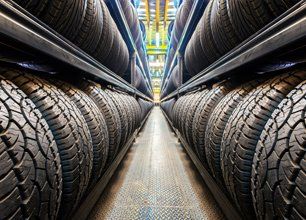The Science Behind Tire Fixing and Safety And Security
When it pertains to the intricate globe of tire maintenance and security, there exists a world of science that usually stays hidden by the typical driver - morris tire service. The materials that compose a tire, the effect of tire pressure on overall safety and security, the ramifications of walk wear, the detailed dynamics of tire traction, and the often-overlooked significance of proper wheel positioning all play important duties in making certain a car runs safely and efficiently. As we navigate via the complexities of tire repair service and safety, it ends up being apparent that a deeper understanding of these clinical principles is not just beneficial but crucial for every vehicle driver when driving
Tire Composition and Functionality
What products make up the composition of tires, and how do these elements contribute to their functionality on the roadway? Steel cords are incorporated to boost the tire's toughness and assist it keep its shape under various roadway problems.
The structure of tires plays a critical duty in their functionality when traveling - morris tire service. The rubber compounds provide grip and grip, permitting the tire to stick to the road surface and supply security during acceleration, braking, and cornering. The textile and steel layers contribute to the tire's capability to stand up to stress, maintain its form, and support the vehicle's weight. In general, the mindful selection and mix of these products guarantee that tires can carry out effectively and safely on numerous road surface areas and problems.
Effect of Tire Pressure on Security
On the other hand, overinflated tires have less call with the road surface, minimizing traction and causing uneven wear on the tire treads. Appropriately inflated tires also play a vital role in fuel effectiveness, as underinflated tires can increase moving resistance, leading to reduced gas mileage. Frequently examining and preserving the correct tire stress not just makes certain security however also extends the life expectancy of the tires, saving on substitute expenses in the lengthy run.
Footstep Put On and Its Ramifications
Correct surveillance of tire tread wear is crucial for making sure ideal performance and safety and security when driving. As tires wear down, the deepness of the walk lessens, reducing the tire's capacity to maintain grip, specifically in unsafe or wet conditions. The step pattern and depth play a vital role in carrying water away from the tire to stop hydroplaning and keeping grip when traveling surface.
Signs of excessive tread wear consist of hairless spots, irregular wear, and the appearance of wear indicators. Hairless places suggest local wear, which can lead to instability and boosted risk of blowouts. Uneven wear may recommend issues with tire placement, inflation, or suspension parts. Put on indicators are constructed into the tire tread and become noticeable when the walk deepness gets to a specific nadir, indicating the demand for prompt substitute.
Understanding Tire Grip Characteristics
Monitoring tire walk wear not only makes certain optimum efficiency and security yet likewise straight influences the grip dynamics of the tires on various road surfaces. Tire grip is an important element of lorry handling and security, as it figures out the grip in between the tires and the roadway. Traction dynamics differ relying on road conditions such as completely dry pavement, wet roads, snow, or ice.

Recognizing tire traction characteristics is essential for chauffeurs to adjust their driving behavior according to the roadway problems. tire tracks morris il. Consistently examining tire step deepness and problem can significantly improve grip performance, making certain safer driving experiences throughout various surfaces
Value of Proper Wheel Positioning
Ensuring correct wheel alignment plays an essential role in maximizing automobile efficiency and extending tire long life. Appropriate wheel positioning involves adjusting the angles of the wheels to supplier requirements, guaranteeing that they are perpendicular to the ground and parallel to each other. When Click This Link alignment is off, it can bring about irregular tire wear, decreased gas effectiveness, and jeopardized handling.
One of the vital advantages of preserving correct wheel positioning is enhanced dealing with and security. Misaligned wheels can create the vehicle to draw away, affecting steering control and total driving experience. In addition, proper alignment promotes even tire wear, protecting against premature tire replacement and minimizing maintenance prices in the long run.

Conclusion
In verdict, the scientific research behind tire fixing and safety and security is critical for preserving vehicle efficiency and guaranteeing chauffeur safety and security. By comprehending tire structure, pressure, tread wear, traction dynamics, and wheel alignment, motorists can avoid crashes and lengthen the lifespan of their tires.
The materials that make up a tire, the impact of tire stress on total safety, the implications of tread wear, the detailed characteristics of tire traction, and the often-overlooked significance of appropriate wheel alignment all play important functions in ensuring browse around this site an automobile operates safely and effectively. On the various other hand, overinflated tires have much less call with the roadway surface area, reducing traction and triggering uneven wear on the tire footsteps. Consistently inspecting and keeping the proper tire stress not just ensures safety yet also expands the life-span of the tires, saving on substitute costs in the long run.
Keeping an eye on tire walk wear not only makes sure optimal performance and security yet additionally straight influences the traction characteristics of the tires on different road surfaces. Tire traction is a vital facet of lorry handling and security, as it determines the hold in between the tires and the roadway.